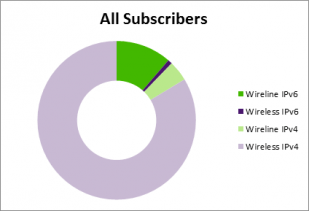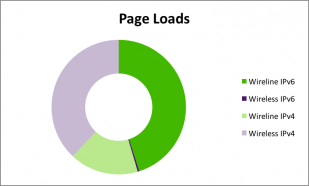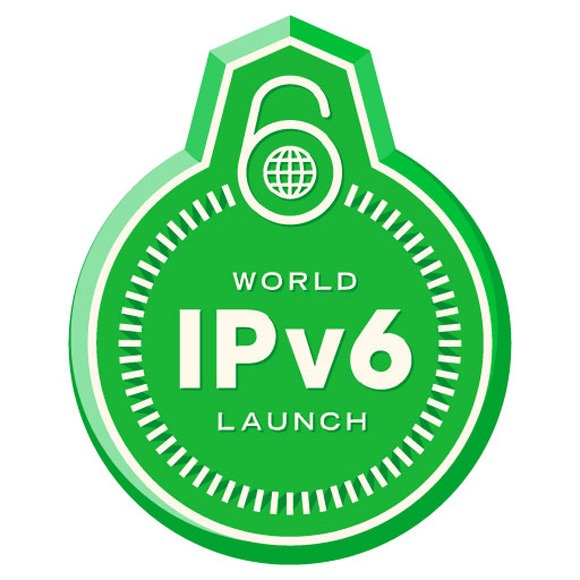As the engineer responsible for IP Address Management at TELUS, I highlighted the risk of IPv4 exhaustion a few years ago, and with support from executives and the great technical strength of our team we have faced the problem head on for both our home Internet service (wireline) and our mobility service (wireless). According to World IPv6 Launch measurements, we’re in the top 10 globally with 44% of the users on our network enabled to use IPv6.
I have some insight I could keep to myself, but I prefer to share because I hope others in the community will find it interesting or even helpful. Specifically, I have the benefit of looking at how the mix of Wireline and Wireless subscribers and their respective IPv6 enablement fits with the overall TELUS IPv6 deployment result of 45%. This insight in fact opens the door to understanding how many sessions or page loads occur on Wireline networks versus Wireless networks.
Let’s start with our subscriber numbers. As of our most recent quarterly report, TELUS has 1,544,000 wireline Internet connections and 8,421,000 wireless subscribers. What we don’t report there is the percent of IPv6 enablement done for those subscriber groups. Today, 73% of Wireline subscribers have IPv6 enabled, whereas that number is only 2% of Wireless subscribers.
But to give you an idea of the respective scale (remember we have over 8 million wireless subscribers compared to roughly 1.5 million wireline subscribers), the “All Subscribers” graph combines the two.

Now you can see quite clearly that we aren’t anywhere near 45% IPv6 enablement on a subscriber basis. We are quite close to 13% enabled on a subscriber basis. This does not suggest a disconnect between the numbers I am sharing and the measurements shown on the World IPv6 Launch site. Instead, it reveals clues to the relationship between page loads and subscribers.
Running the numbers gave me a chance to see that TELUS Wireline subscribers generate 59% of the page loads despite representing a much smaller percentage of our subscribers (see the green areas in the graph). Further calculations revealed that for every page load generated by a wireless subscriber, our wireline subscribers generate 8.73! Now in a way, this makes sense. Although I am calling them wireline subscribers, this conceals their nature. They are connected homes with couples, families, friends, roommates and tenants occupying them. And not only are there more people behind each one of those subscriptions, but they are likely to do a little more web browsing at home than on the go.
The result of those calculations was to show how 45% of the overall page loads are IPv6 enabled (the dark area in the “Page Loads” graph).

There is one more thought I have on how to use this information. If I could know the average number of people per household I could estimate (on average) how much more we browse the Internet at home versus out over mobile networks. Canada’s population of 35 million lives in a little over 12 million homes, so that there is an average of 2.82 people per home. That 8.73 ratio earlier divided by 2.82 gives us 3.1, telling us that in Canada, as of January 2016, we browse more than three times as much at home as we do on the go.
Like me, you might be wondering how a blog you expected to revolve around IPv6 ended up focusing on the comparison of Canadian browsing habits at home versus out of the home. I hope though that also like me, you leave with the impression that combining various measures can reveal interesting truths. I also leave this blog thinking a little more about how I use the Internet. One thing remains absolutely clear; it is incredible to have the Internet at our fingertips whether we are at sitting a desk, reclining on a couch or out with friends.
